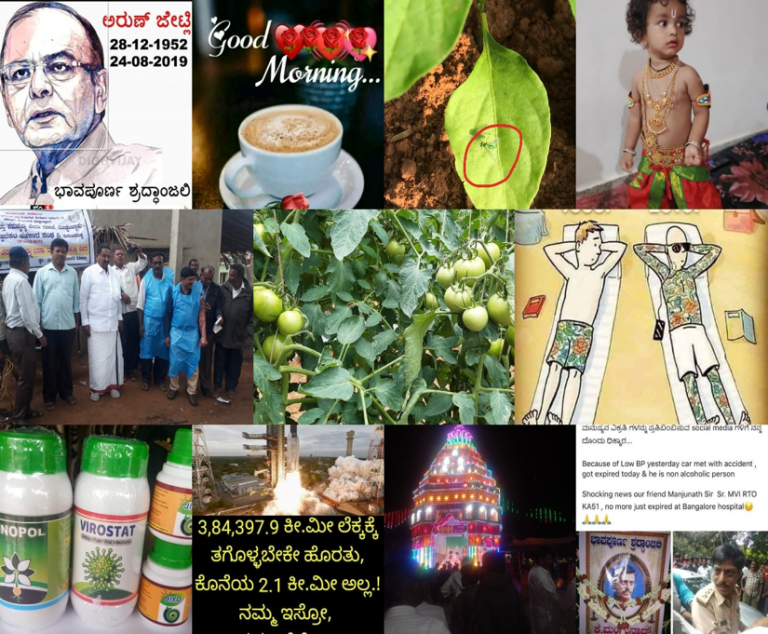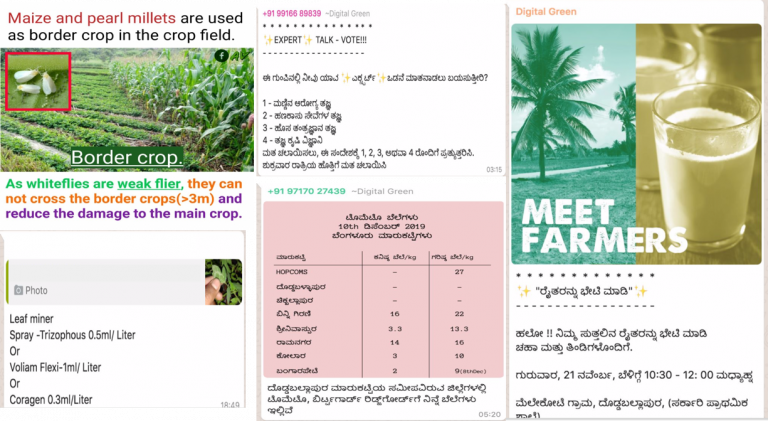While mobilization of farmer groups in India is a promising and accelerating trend, sales and marketing remain key challenges for these groups.

As countries across the world went into lockdown to break the chain of the Coronavirus pandemic, we found novel ways of keeping in touch, exchange information, spread awareness. One of the most interesting things I noticed in the initial days was the ‘virality’ of videos that explained how the COVID-19 virus spreads, as I received the same videos from multiple contacts on the various social media applications. Another feature was the increased use of the internet-based messaging application WhatsApp by local communities that shared hyper-local information that could be at such times indeed lifesaving!
Working with Digital Green I have seen the power of videos in translating complex information into clear and easily understood messages; interacting with the farming communities I have also understood the value of community networks.
At Digital Green, I have been working with various teams to think beyond our popular video-based extension approach which has helped farmers reduce input costs and improve their yield; but we want to do more, we want to help increase their incomes. For this reason, we’ve been watching closely how the rural farming communities have been adopting smartphones and going online in the last few years. The views and subscriptions of our YouTube channel started exploding just as we saw many farmers becoming YouTube sensations and influencers.
This had us fast-forwarding our own plans. Late last year we created a multidisciplinary task force that spent weeks carrying out desk research, holding ideation sessions at work, followed by farmer interactions on the field to find that one eureka moment. The apple didn’t drop. But we were besieged by a number of ideas. We decided to go ninja on each such spark, take quick small steps to tackle them all.
We found that our audience (in this pilot project rural Bengaluru, Dodaballapur) was most active on WhatsApp. And that while they were active on the platform it was confined to personal interactions, leisure, and entertainment; rarely for information or building new networks/connections. We also found that the village community was quite fragmented, they were unaware of fellow farmers in their own village and therefore unable to leverage useful information through this new medium of communication. Our experience over the last decade or more has taught us that agricultural practices, problems, and needs are quite hyperlocal in nature, which we find are best tackled by strengthening the community networks.
Thus, we decided to build a hyperlocal farmer’s community on WhatsApp giving them a space to share their farming stories, problems, queries, and successes which could be heard, appreciated, and addressed by experts as well as peers. And once the ground was fertile we wanted to layer it up with more value-added services for the community which could help them fulfill their latent aspirations, increase their income, and bring convenience to them.
We decided to take an iterative human-centered design approach. We started by creating a WhatsApp group by adding a few farmers we had built a rapport with and waited to see how the groups would grow and evolve organically. For the first few weeks, there was no moderation, we encouraged farmers to add other farmers to the group, to post content which they wished to share with their peers. We saw a lot of posts coming through ranging from politics to religion to family pictures (yes, a lot of good morning messages with photos of flowers too) to even some farming related posts. The group which started with 6 farmers had grown to more than 100 farmers in just a month and mostly all organically. The group was not silent for even a single day since it started which was very encouraging. While all of this gave us good learnings but it was not exactly what we were working towards – building a healthy online farming community where farmers exchanged information around agriculture and allied activities.
That’s how we learned that to build an online community, we had to grow and nurture it. We chalked out and executed many small experiments to run on our group, such as video chat with an Ag-expert, polls, and competitions, etc. We set clear success indicators for each experiment which would guide us in making ‘go’ or ‘no-go’ decisions. Since the reaction to experiments run on WhatsApp were almost immediate we made it a point to synthesis our learnings as a team at the end of each day – this was really helpful in keeping us on track, we were conscious of each decision taken and ensured we would never go back to ‘reinventing the wheel’.

We deliberated on our messaging strategy and we even came up with 3 metrics that our content had to fulfill – it must be Relevant, Engaging, and Inspiring. Our posts now focused on:
This change in the quality of interactions was heartening for us as well as the farmers, who have come to take great pride in being associated with these groups. The members also take tremendous ownership in maintaining the quality of discussions. They value the time spent on this group and if someone toes the line by sending in irrelevant content – another member is quick to share the community guidelines that were developed over the course of the groups’ lifetime.
This experience of careful observation of how the community was engaging on the platform, synthesizing, and iterating helped us grow the groups into effective channels of communication for a network that was fruitful for all. It gave us great confidence to create and engage online communities which we are now applying in other use cases – both agriculture as well as health and nutrition interventions.
